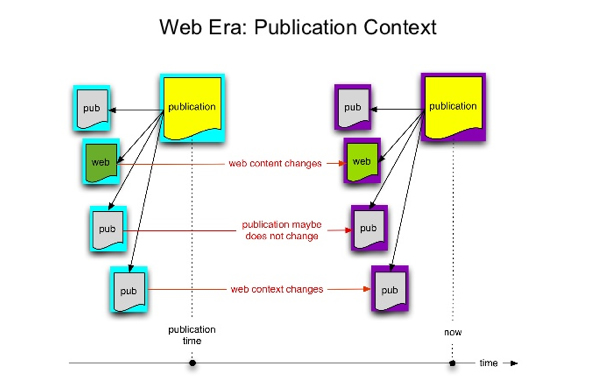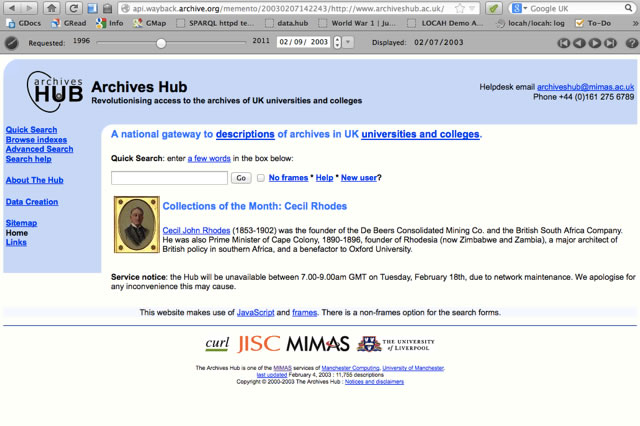 This post picks out some highlights from a report from Ithaka S+R, “Supporting the Changing Research Practices of Historians” by Roger C Schonfeld and Jennifer Rutner (December 2012). It concentrates on findings that are of particular relevance for archivists and for discovery. The report is recommended reading. It is a US study, but clearly there are strong similarities with other countries.
This post picks out some highlights from a report from Ithaka S+R, “Supporting the Changing Research Practices of Historians” by Roger C Schonfeld and Jennifer Rutner (December 2012). It concentrates on findings that are of particular relevance for archivists and for discovery. The report is recommended reading. It is a US study, but clearly there are strong similarities with other countries.
The report finds that underlying research methods are still broadly as they were but practices have changed considerably: “Based on interviews with dozens of historians, librarians, archivists, and other support services providers, this project has found that the underlying research methods of many historians remain fairly recognizable even with the introduction of new tools and technologies, but the day to day research practices of all historians have changed fundamentally.”
It goes on to summarise the improvements that archives might make to meet changing needs, none of which are unexpected: “For archives, we recommend ongoing improvements to access through improved finding aids, digitization, and discovery tool integration, as well as expanded opportunities for archivists to help historians interpret collections, to build connections among users, and to instruct PhD students in the use of archives.”
It is very encouraging to see the positive comments about researchers’ interactions with archivists: “Having a meeting with the archivist and librarian is really fantastic, because they help you understand what is in the archive, and what you might be able to use.” It is clear from the study that archivists have a vital role to play as key collaborators and colleagues of historians, and their value is clear: “Archivists are often able to hone and direct an inquiry, bringing to light items and collections that the researcher may have been unaware of.”
The study does highlight the changing nature of interactions with archival material, as a result of the use of digital cameras in particular, which enables the analytical work to take place elsewhere. It is generally felt to be a convenient and time-saving option, enabling long-term interaction with resources outside of the reading room. This development is actually described as “the single most significant shift in research practices among historians.” It raises questions about whether the role of the archivist changes when the analytical work is displaced from the archive, as archivists may have less opportunity for intellectual engagement with researchers. The study does highlight a possible issue with digital copies, namely the separation of metadata from content, where the researcher has hundreds of images and needs to organise them constructively, and it also found that scholars are struggling to work with digitised non-textual content effectively.
The ability to find time for research trips was a primary challenge for many researchers. “Interviewees repeatedly emphasized that the amount of time they are able to spend in the archives shapes the nature of the interaction with the sources significantly.” Because most struggle to find time for research trips, digitised sources are hugely beneficial.
The study found that digitised finding aids help researchers to “travel more strategically”. It suggests that high-quality finding aids may become more important as researchers move more towards photographic visits to archives, rather than serendipitous visits. This connection is something I have not thought about before, and I would be very interested to hear what archivists think about this idea.
Of major relevance for a service like the Archives Hub is the conclusion about finding aids:
“The use of online finding aids greatly facilitates, and sometimes displaces, these visits. If a “good” finding aid is readily available online, this might make a scouting visit unnecessary, depending on the importance of the archive to the research project. In some cases, researchers were able to rule out a visit to an archive based on the online finding aids, and re-purpose funds and effort to tracking down other sources for the project.”
This study is a clear endorsement for our belief (which, I should say, is also backed up by our own researcher surveys) that finding aids play a role not only in identifying and prioritising sources, but also in providing enough information in themselves to make a visit unnecessary. As well as this, they may have a kind of positive negative effect: the researcher knows that materials can be ruled out. The study strongly emphasised the need for “searchable databases” and “centralized searching” and participants talked about the problem with locating each collection independently, especially across the diverse types of archive repository: “The process of identifying archives – in some cases small, local archives or international archives – can present an amazing challenge to researchers.” Clearly comprehensive cross-searching search tools are a huge boon to researchers.
In terms of discovery, Google is clearly a major tool and there was a feeling that it was the most comprehensive discovery tool, as well as being convenient and easy to use. It is often used at the start of a searching process.: “Generally, historians discover finding aids through Google searches and archive websites.” There is a clear demand for more descriptions online: “The general consensus among interviewees was that more online finding aids would greatly benefit their research, and that archives should continue to make efforts to make these accessible online. Continued and expanded efforts to develop finding aids more efficiently and to make them available digitally would seem to support the needs of historians for improved access.”
In terms of PhD students (and maybe others who are inexperienced researchers), the study found issues with the use of archives and other sources:
“Interviews with PhD candidates indicated that there is often little support for them in learning about new research methods or practices, either in their department or elsewhere at their institution, of which they are aware. While the subject matter treated by historians continues to diversify dramatically, new methodologies develop, and research practices change rapidly, it is clearly critically important that students have a grounding in the methods and practices of the field.” The Archives Hub has recently produced a brief Guide to Using Archives for the Inexperienced, and discussions on the archives email list showed just how much this is an important topic for archivists and how there was a general consensus that PhD students need more training on research methodologies.
Summing up, the report makes six recommendations specifically for Archives:
1. More online finding aids
2. More digitisation
3. Discovery tools that promote cross-searching, crossing institutional boundaries and encompassing small and local record offices
4. Adequate resources for ensuring the expertise of the archivist continues to be available, enabling archivists to be active interpreters of the collections
5. Adapting to and facilitating the use of digital cameras and scanners in reading rooms
6. Training PhD students in the use of archives
There is a great deal more of interest and relevance in the report around searching, Google Scholar, the use of the academic library, organising and managing research, citation management and digital research methods. It is very well worth reading.












